HOME
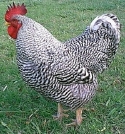
~~~Throughout this site, simply hover your mouse over each picture for a pop-up caption to explain what or who it is.~~~
Chicken Health
The average chicken hatches after 21 days of incubation, is old enough to be on it's own (away from mama) at 2 months, reaches puberty (hens begin laying eggs, roos begin mating hens) at 6 months old and have a life span of 9-13 years, give or take a few years either way. Their life span, of course, depends on their health, breed and lifestyle.
FEEDING
We feed our free-range birds a standard scratch mix and lay mash, supplemented
with plenty of fresh water, free choice oyster shell/grit, grass, dirt to
scratch in and table scraps. As far as table scraps go anything that is good
for you, is good for them--and vice versa. Some people give their birds as
a treat warmed food in wintertime or cold food in summer, which chickens
seem to love. Mine love frozen grapes or ice cubes to play with on summer days! A varied
diet also stimulates your birds, they do like to have fun. Chocolate
is toxic to birds and you should never feed raw meat because of the parasites
it can carry. My chickens love cooked chicken and eggs (both cooked and raw),
but some people shudder at this. Egg shells are a wonderful source of calcium,
and chickens need a calcium source such as oyster shell, or a calcium
supplement in their feed. I've never had my chickens turn into egg-eaters
because of giving them eggs, by the way. My birds love the occassional egg
and shell. Chickens usually turn to eating their own eggs because of a deficiency
in their diet or boredom, stress and overcrowding. When a hen lays eggs she
is using calcium, and if she can't get it any other way she will eat her
own eggs. It's either that or her body will rob it from her bones, which
will leave her weak and can be deadly. Chickens also need a source of grit in order to break down their food--they don't have teeth! You can buy bird grit at most pet stores, but mostly chickens ingest dirt and small stones in their normal foraging for grit.
TOXIC PLANTS AND HOUSEHOLD SUBSTANCES
Certain plants are toxic to birds, you can do a search for 'plants toxic
to birds' on the internet to find lists of both safe and unsafe choices.
Chickens will eat most any plant they can reach and their scratching for
food can be destructive to just about any plant, so plan your garden
accordingly. :) I had a female turkey once who killed a 4 ft. x 4 ft. mature
artichoke plant merely by sitting on it. All of the time. Every day. For
days. And days. VERY determinedly! Certain household solutions, such as bleach and antifreeze, are also toxic to birds. Chocolate is toxic, and raw meat can carry dangerous bacteria such as Salmonella and parasites.
Great page here on what is toxic and what is safe:
http://www.plannedparrothood.com/plants.html
BASIC CHICKEN MAINTENANCE
In addition to you regularly visually and physically checking out your birds, once in a while you may need to trim wings and toes. There is a link to a terrific wing clipping page on my home page. To trim nails, you can use a human nail clipper (the large kind for toenails) or buy a special nail clipper for dogs that looks much like a pair of pruning shears. When you clip nails, be sure to have a good grip on the bird and a steady hand. Enlist someone else's help if need be to hold the bird while you trim the toes. Only clip off the very end of the nail, avoid the darker area because that's where the blood supply is and trimming off too much can cause bleeding. Have your bottle of Kwik-Stop ready just in case. If you do cause bleeding, make SURE you get it stopped before releasing the bird. Clipping too close hurts, just as it would hurt you to cut your finger. You shouldn't ever have to trim beaks, but if you do, follow the same procedure as for toes, and be VERY careful NOT to clip the pointed end of the tongue!
BATHING CHICKENS
Mostly it takes baby shampoo, lots of towels and patience. Our friends at Brown Egg Blue Egg.com have great articles on both washing chickens and wing, beak and nail trimming:
http://www.browneggblueegg.com/Article.html
MOLTING FEATHERS
Molting is when a bird will suddenly lose a lot of their old feathers and over the course of a few weeks, grow in new ones. All birds molt, and in chickens the molt can vary widely--a 'hard molt' is when most of the feathers are shed while a lighter molt may involve just a few areas of the body. You may first notice your birds losing most or all of their tail feathers at once. Losing all of the tail feathers can be a bit of a problem within the flock socially since how they carry their tail is an indicator and conveyor of emotions--tail up and spread is a sign of aggression or alert fear, tail tucked and down submissiveness or submissive fear. If other chickens can't read this signal because of the missing feathers, the molting bird may get an extra peck or two. Nothing too serious though.
My Head Hen, Bear, always does a hard molt and tends to look like a Chernobyl victim, it can be VERY startling to suddenly find one of your birds in this condition--you also get a good look at all of that pink skin and realize how small they are WITHOUT all their feathers, it's downright unsettling.
Here is Bear, over the course of several days one December when she started to molt:
Day 1
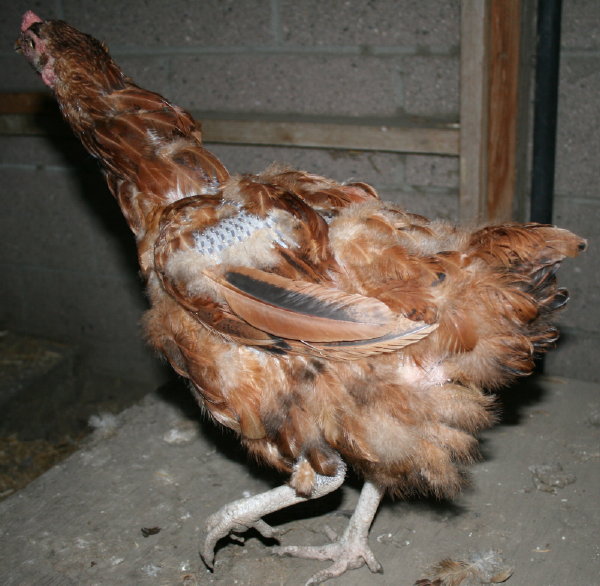
Up close it was even worse...
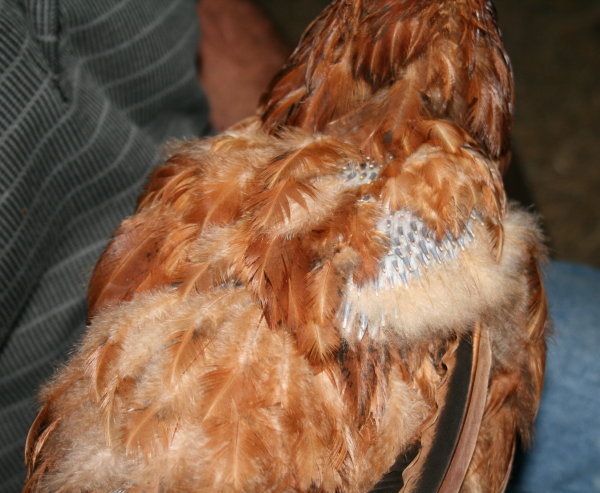
Day 2
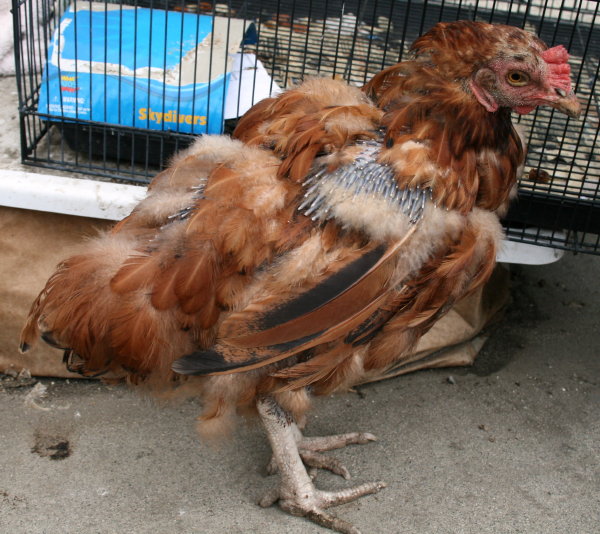
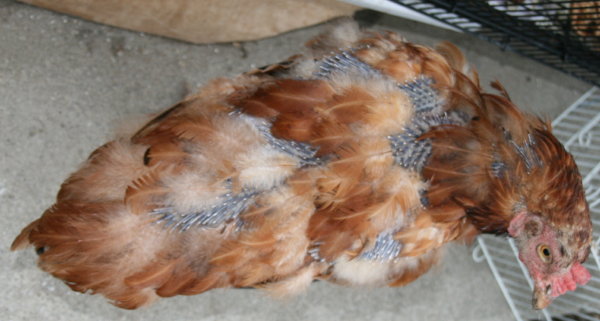
Day 3.
As bad as it gets without the chicken outright dissolving, I guess. At this point the new feathers are REALLY coming in and Bear was spending all of her time being Super Grump and preening.
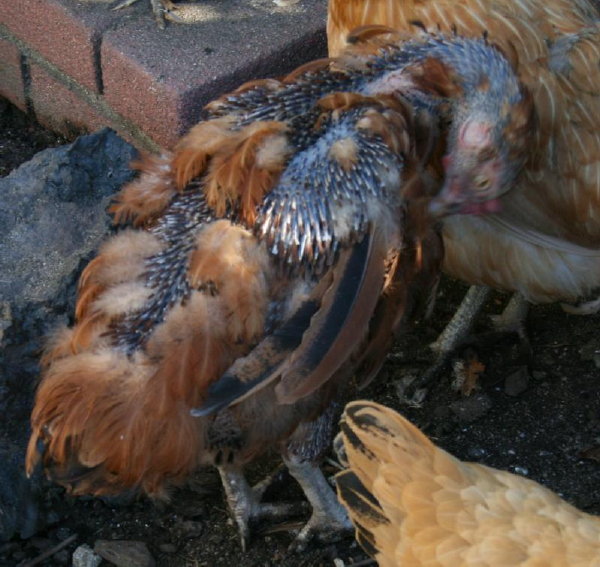
The hen in front of Bear in this shot is her daughter, Beast, who was also molting right along with her mother. Phoenix, our Head Roo, was the only one who could safely get near Bear. He positively radiated sympathy.
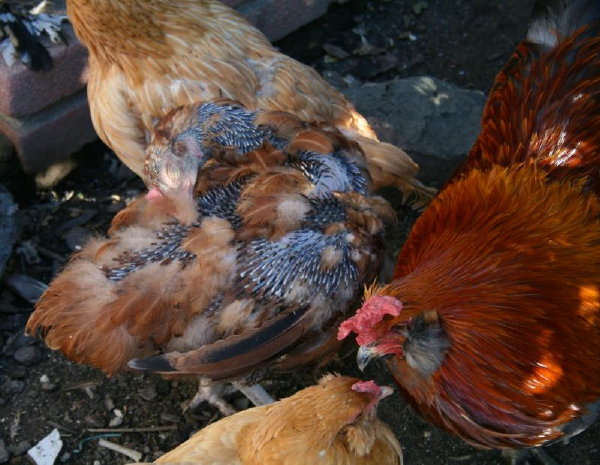
The final shot, wherein Bear is shooting me the look she has perfected after all these years of molting: The Bear Glare. This laser-edged look can peel paint at 50 yards.
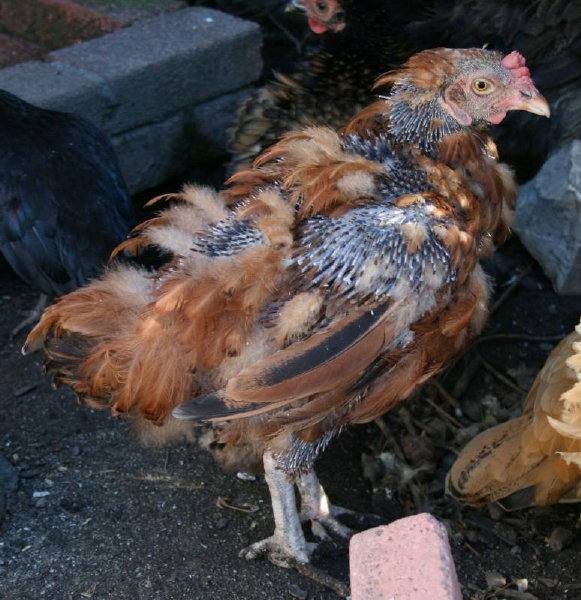
Happily, all is not lost, and less than two weeks later Bear has regrown herself a beautiful new suit of feathers and is her old perky self again.
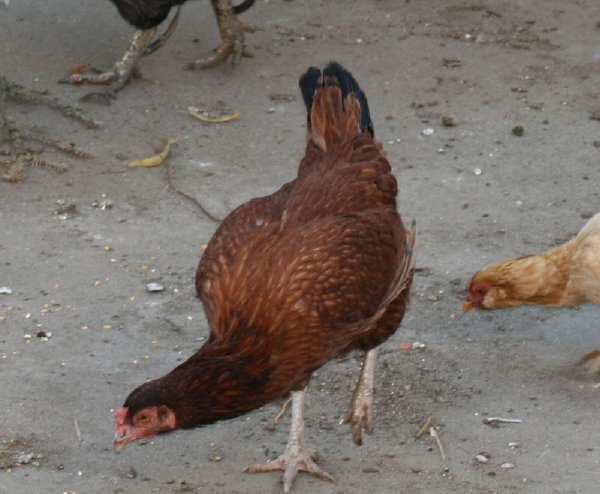
...and sneaking into the kitchen to beg for goodies.
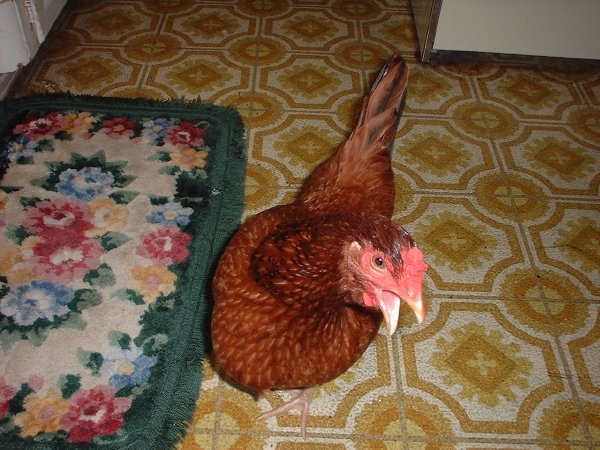
Lots of chickens do a hard molt after reaching around one year of age, give or take a few months in either direction. After that most molt once a year. It can vary widely from breed to breed and from chicken to chicken. Some do it in the summer, some in the winter (when you figure it'd be the worst possible TIME to molt!). While molting isn't an illness per se, it IS a big stressor on the chickens' system. You can help your birds along by providing a bit of extra protein in their diet--growing new feathers takes lots of protein! Live mealworms or crickets, scrambled eggs, cooked ground beef, etc. are all great protein sources. The one advantage to molting in the winter is that the cold weather can stimulate new feather growth. If your birds are molting in the winter, try to protect them from drafts. Especially important is to try not to handle your birds during a molt--those new pinfeathers HURT when they poke them when you pick them up! Also, blood feathers (new, growing feathers with the blood supply inside the shaft) can become broken off, which can cause significant bleeding, even to the point of endangering their health. A broken-off blood feather can act like a straw, causing the bird to lose a lot of blood. If a blood feather DOES break off, apply a bit of Kwik-Stop (coagulent made for birds) if you have it, if not you can use a bit of cornstarch or even flour to staunch the bleeding.
When a chicken is molting, they will naturally be a bit withdrawn, depressed, listless and grumpy. They may irritably peck flockmates and generally be a pain to be around, and may hide. This is Bear on the right and her daughter, Beast on the left--they were molting at the same time and were actively hiding...
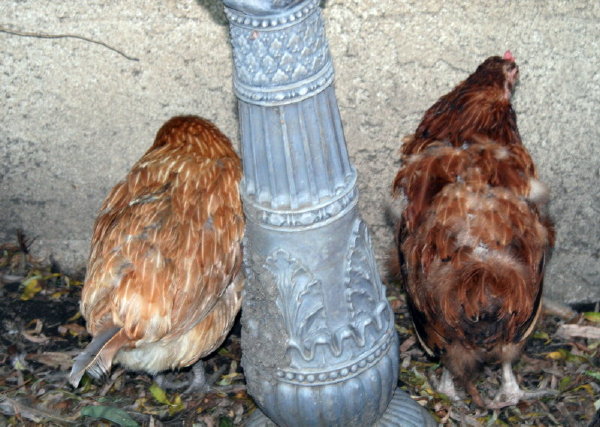
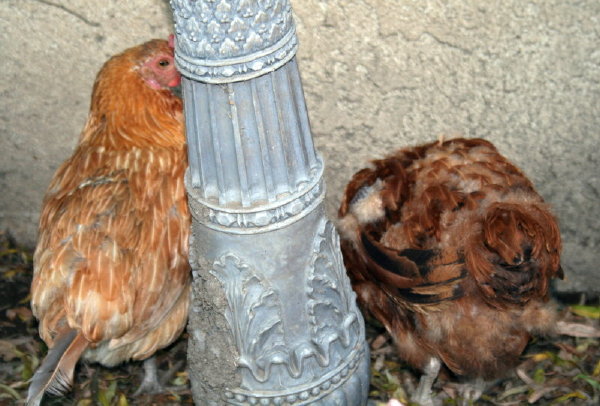
I think they know they look funny, poor babies! Chickens appreciate praise just like dogs & cats do, so coo at them and tell them how pretty they are to cheer them up a bit, it helps. It won't be long before they are carrying a beautiful new suit of feathers and an improved attitude.
CRESTED BREEDS
Crested breeds are birds with a crest of feathers on the top of their heads, such as Silkies and Polish. Since humans are always breeding for bigger crests on these fancy fowl, some crested breeds have actually developed a hole in the top of their skull, through which their brains protrude! There is a great article on it here entitled "Silkie Skull", along with a link at the bottom of THAT page to another page on crested fowl and cerebral hernias (with great info on how and why you should trim crested fowl a bit to help them see), make sure to read both pages:
http://www.browneggblueegg.com/Article.html
Since Silkies and Polish in particular not only have the open skull but their feathered crests can obscure their vision, sometimes they don't see another chickens' posturing (lowered head and hackles flared, or standing tall and facing the other bird aggressively) warning of a head peck coming. So they don't know to get out the way or duck, and take a neasty peck to the top of the head--which is the primo spot for teaching other birds in the flock their place. When a crested bird suffers a 'Head Boink' (our technical term for it), it can cause brain injury (also commonly called Crookneck or Limberneck) and sometimes death. Head injuries can also happen during shipping of birds or if the bird is startled and bumps it's head, a nasty respiratory infection such as a head cold can also cause the brain to swell. Symptoms are the birds' inability to stand properly or lift it's head, backing up constantly, tucking it's head between it's legs, a drunken stagger, dragging it's head from side to side on the ground or flipping upside down. Crookneck/Limberneck can also be caused by a nutritional deficiency, but in these days of balanced nutrition chicken feed it doesn't happen very often--usually it's because someone has raised a chicken on a diet of just bird seed, for instance. There are home treatments for Head Boinks that work well most of the time, but they are lengthy and the bird takes a lot of care and some handfeeding. Happily, I have used Dr. Stanford's Vitamin E/Selenium treatment with complete success.
HANDFEEDING SICK BIRDS
If you have a sick bird and need to hand feed it, here's what I do:
first I keep the bird warm and quiet, placed on a heating pad if need be.
Place your palm firmly on the heating pad for at least 45 seconds,
The heating pad should warm to your hand but NOT hot--don't burn your bird.
Both the food and the bird should be warm for the best results. If
you can get hand-feeding powder manufactured for all baby birds at your local
pet store, great. Keep it in the frig in case you need it. If
not, at the grocery store you can get Gerber mixed cereal for babies (a flaky
powder to mix with milk or water), a jar EACH of stage 1 strained chicken,
carrots and peas (or any meat, green vegetable and orange vegetable).
Also get a bottle of unflavored Pedialyte (a liquid that has electrolytes
in it) or use the recipe for homemade electrolyte solution below, and a small tub of unflavored yogurt with live cultures. Check
the expiration dates on both the Pedialyte and yogurt to be sure they are
still good, expired stuff is useless. Mix this to a loose paste consistency
and warm it a bit--not too hot, it should just feel warm to your hand, around
100 degrees. If you use a microwave make SURE to stir the mixture!
If your bird is not eating or drinking you need to provide both food and
moisture, that's where the baby food and Pedialyte come in. Some people
debate the wisdom of giving dairy products such as yogurt to birds--some
say that birds cannot digest dairy. On the other hand, yogurt with
active cultures helps replace the 'good' natural flora in the gut that a
round of antibiotics has killed off--antibiotics don't discriminate and kill
'good' bacteria AND 'bad' bacteria, which can cause diarrhea and dangerous
dehydration in birds. In my experience small amounts of yogurt have
been more beneficial then harmful--use your best judgement and everything
in moderation! A great alternative to yogurt is BeneBac, a gel containing
active cultures made for birds and sold in pet stores. Again, check
the expiration date, though.
Homemade Electrolyte Solution Recipe
Here is a recipe for an electrolyte solution you can make at home, equivelant to Pedialyte. Be SURE to keep it refrigerated and to make a fresh batch every 12 hours.
Mix together until all dry ingredients are dissolved:
1/2 Qt. Water
1 tsp. Sugar
1/4 tsp Salt
1/4 tsp. Baking Soda
To feed a sick bird, first get it warm and then wrap the bird in a towel.
This helps keep the bird calm and contains it's wings. I just drape
the towel across it's back and tuck it in around it's feet, then hold it
in my lap and under my arm like a football. To feed the mixture you
don't need to worry about getting the food down the bird's throat, just place
the food in it's mouth and let it swallow. This is safer than worrying
about using a syringe and trying to remember which hole in the birds' throat
goes to it's lungs and which goes to the crop! Just so you know, though: Birds have TWO holes in their mouths--the one under the tongue is for breathing through and the one at the very back of the throat is for food & water. If you force food down
the wrong way the bird can aspirate food into it's lungs, which in turn can
cause pneumonia and death. To get the food into the birds' mouth, you
can use a handfeeding syringe from the pet store, your vet or pharmacy (it's just a
disposable plastic syringe with a long tube instead of a needle, also called an 'irrigation syringe'), an eyedropper
with a large opening, a baby ear bulb syringe, a wooden matchstick or Qtip with the cotton removed, your finger dipped in food,
etc. Just make sure the opening in the syringe is large enough for the food to pass
through it without clogging it. You may have to handfeed the bird every
couple of hours during the daylight hours. At night allow it to sleep
naturally while still keeping it warm and quiet.
If a sick bird is still eating on it's own, in addition to chicken feed you
can help it along by offering scrambled eggs, cooked hamburger, diced grapes
and tomatos, live mealworms, raw corn, etc., along with the Pedialyte to
drink. Spoil it for now, give it plenty of goodies. The idea
is to get the bird to eat and keep eating. If the bird was worth investing
your time and money in in the first place to own it, it's worth investing
a little time in to give it a shot at recovery.
INJURIES
I keep a little bottle of a powdered medication called "Kwik-Stop" on hand
at all times. It is basically a styptic powder to stop bleeding. Chickens
are, after all, birds--and birds are very delicate and can bleed to death
or go into shock from injuries very quickly. With Kwik-Stop all you do is
use a dampened Qtip or cotton ball to apply some of the powder right to the
wound. It seems non-toxic--I have even used it inside a hen's mouth who had
somehow managed to rip her tongue out (remember that chicken motto?) and
was bleeding badly. I figured that she was dead from bleeding if I didn't
use it , so there was nothing to lose. That hen is just fine nowadays and
other than having to learn to eat again without a tongue to help her swallow,
gets along well. My vet told me later that ripping a tongue out is actually
a fairly common injury for chickens! Usually chickens will peck at
any blood they see on another bird--it's instinctual--so it's important to
clean up any injured birds and sometimes quarantine them away from the flock
for a few days until the injury has healed a bit. In a pinch, cornstarch
can also be used to stop bleeding, flour works too to a lesser extent.
Anytime you have a sick or injured bird, do what you can for it quickly at
home, but also call the vet! Remember to keep your bird warm and quiet
to guard against shock, which all by itself can kill a bird.
WORMING AND DUSTING/SPRAYING
I'm not an expert or a vet, but this is what works for me. I've been doing
it this way for years with no ill effects. Poultry are subject to an amazing
number of parasites and illnesses. Gapeworm, roundworms, mites, etc.
are parasites carried in by wild birds and can live in the soil, earthworms,
beetles, etc. of your yard, that's why you need to routinely treat your birds--not
just once. Some organisms can lie dormant in the ground for months
or years. In my opinion chickens most DEFINETELY need to be wormed,
once every 6 months--but worming can be hard on birds. I also worm
and dust/mist any new adult birds when I add them to my flock. The parasites
can build up an immunity to the wormer if you use the same one over and over
again. A good bet for chemical wormers is to switch types (Ivermectin
versus Piperazine-17 or Levamisole, for example)--but not too often! Switch types
of wormers every 4-6 cycles (one worming is one cycle). More frequently
will just cause the worms to build up an immunity to BOTH wormers more quickly. Also, NOT ALL WORMERS ARE EQUAL! Choose the right product for the problem. Ivermectin is the one to choose to treat a broad spectrum of parasites, while Piperazine will ONLY kill roundworms. I use a product for horses, a paste wormer called Equimax which is 1.87% Ivermectin and 14.03% Praziquantel. It's a broad-spectrum wormer that kills nearly everything.
GameRooster.com has a great page on parasites, which meds kill which worms:
http://www.gamerooster.com/disease/parasites.html
You'll want to not eat your hens' eggs for about two weeks after worming them
with Ivermectin. Gapeworms are really roundworms which infest the trachea
of the bird. If you worm your birds every six months with a good all-purpose,
broad spectrum wormer such as Ivermectin 1.87% you shouldn't have a problem.
Gapeworms are usually found in soil contaminated by turkeys or wild birds,
so there isn't really much you can do to keep the wild birds out of your
yard. The symptoms of Gape are listless attitude, the feathers are carried
loosely and the breathing is asthmatic in nature--especially at night. The
birds sleeps a great deal during the day to make up for it's poor rest at
night, and every few minutes will thrust it's head forward and open it's
beak wide, working it's neck in a motion that looks as if it is trying to
swallow something or yawn. Sometimes a REALLY infested bird will actually
cough up a bunch of worms, and may then turn right around and eat them. *ulp*
Or worse, another bird may run over and gobble them up, then becoming infested
themselves! Adult birds appear to tolerate or throw off an infestation
better than young birds.
Here's what a Gapeworm looks like, if you really want to see one:
http://cal.vet.upenn.edu/projects/merial/Strongls/strong_4.htm
Ivermectin 1.87% (Equimax) is a paste sold in tube (syringe) form and marketed towards
horse owners. You can pick it up at most feed stores or online. I buy it
ahead of time on Ebay or at online animal medical supply houses such as Valley Vet Supply for about a half to one third of what the feed store charges!
It's easy to do and can be done by one person if you have tame birds, otherwise
it takes two people. All you do is put a small BB size amount in a small
bottle and shake to mix with about 2-3 tablespoons of water. It will be hard
to mix but keep at it. Give each bird 4-6 drops by mouth (shake the bottle
before dosing each bird, the stuff can settle) and, wearing rubber gloves,
also rub another BB size glob under each wing--in that little bare wing pit
area--of each bird.
**IMPORTANT**
You MUST repeat this in 2 weeks to break the worm's life
cycle and kill any hatching worms, after that just do it once every six months.
If you do not give your birds the second round of wormer, the hatching worms
will simply reinfest your birds right away, and you've wasted time, money
and good medicine by not following through correctly. Also the worms
will have built up that much more of a resistance to the wormer, and the
medicine is hard on your birds' internal organs. Use wormer conscienciously
and correctly.
Again, remember: Do not eat your hens' eggs for at least two weeks after using a chemical wormer,
as it can be passed along in the eggs.
DIATOMACEOUS EARTH (DE)
I use a broad spectrum, commercial wormer and have no experience using anything
else, but some people swear by food grade (only!) Diatomaceous Earth (DE).
Diatomaceous earth is made from the remains of fossilized marine algae called
diatoms. The product is mined and reduced to silica powder form. When eaten,
this powder acts as tiny pieces of glass that tear the shells of insects
and other arthropods. Insects die within one to two days from dehydration.
Here's the catch though, and it's a big one--some people swear by it, others
say it does no good whatsoever--and I could not find any studies that were
conclusive one way or another. There is also a question as the whether
DE is OK for chickens to breathe (it's not OK for humans to breathe because
of the way it works--getting silica in your lungs is very dangerous) and
whether it can accumulate in the gut and cause blockage problems. Remember,
chickens scratch a lot and they'll kick this stuff up every time when they
do.
So for what it's worth, here's how one person I know uses it and this is
his experience talking here, not mine: "While wearing a dust
mask to protect your lungs (DE is dangerous to breathe) mix food grade or
agricultural grade Diatomaceous Earth into the chicken feed. Use one (1)
tablespoon of Diatomaceous Earth for each gallon of dried feed, (i.e. chicken
scratch, feed grains, etc.). Also sprinkle it in the pens. The chickens
are dewormed, don't get mites, and there's no flies nor smell in the pens.
The DE will also kill any insects the chickens don't eat. I also feed it
to my large livestock for deworming. DE doesn't kill with poison; it slits
the outer skin of the insect and dehydrates them. 'FILTER grade' DE that
goes into your swimming pool will NOT kill worms, but WILL KILL your livestock.
DO NOT USE 'filter grade' DE on anything living. Only food grade!
With DE there is no need to avoid eating the hen's eggs for a week or two,
and the parasites cannot develop an immunity to DE since it works mechanically,
not chemically, to kill the worm. I've read that since DE only works when
dry, it is not an effective wormer--once it rains and DE gets wet you have
to reapply it. BUT - putting it in feed will help kill soft-skinned pests
in the feed, and also in the droppings, after they have dried. This can stop
the spread of parasites by killing off the pests before they get recycled."
So you see the problem with DE--it may work great or not at all and there
are health issues. Also you have to leave DE out all the time, free
choice so that it can work on any parasites the chickens ingest day to day.
DO YOUR RESEARCH--look up DE on the Internet, ask your vet, talk to other
poultry owners, etc. and then decide. If DE does not work, you should
go ahead with a chemical wormer--better to be safe than sorry. I have
seen no information that states that DE and wormers cannot be used together.
MITES
Mites are tiny, crawling external parasites that are VERY opportunistic little buggers. Usually birds can handle these ubiqitous pests by daily preening and dust baths, but when a bird falls ill and doesn't preen and care for itself as it normaly does, even for just a few days, the population of mites can EXPLODE and pose a serious threat to the already compromised health of sick or injured birds. If your bird is sick or injured with ANY other problem, keep checking them for mites! Mites can and will weaken your bird to the point of killing them if left untreated. Excessive preening and/or 'fear of the coop'--that is, not wanting to go
to roost at night are both signs of external mites. You can check your
bird for external mites by placing the suspected bird on a white surface
such as some white paper towels for about 20 minutes or so. Mites are
attracted to the color white and will migrate from the infested bird to the
white paper towels. You can also check your birds feathers, especially
on their heads & necks, on feathered feet, under wings and the mites favorite hangout, around the vent and under the tail on your chicken's fluffy fanny feathers. On crested breeds such as Silkies and Polish, their head poofs are also favorite mite infestation spots, as well as a Cochin's fluffy feathered legs. If you see tiny, crawling reddish-brown specks, your
birds have mites. Usually these mites don't infest humans, they prefer
birds although they are more than happy to crawl on you and creep you out.
Although Ivermection will also take care of mites, because a wild bird can
infect your birds at any time I also dust my birds for external mites with
powdered Sevin (made by Ortho) or Adams Flea & Tick Mist every six weeks or so. With my birds I prefer the Adams spray, it is FAR less messy, easier to apply and target to affected areas and is less likely to wash off if the bird gets wet. But I will give the application method for both Sevin and the Adams spray here--use one or the other, NOT both at once! If it rains and things get and stay wet and muddy (washing away that Sevin you just applied), you may find the mite problem to be more stubborn, especially on cochins or feather footed and/or crested birds. You just grab a handful
of dust and rub it all over the chicken, especially under their heads, wings
and underbellies, massaging it down to the skin. Really rub it in, it needs
to be down next to the skin. Same with the Adams spray, part the feathers and spray it on the base of the feathers as well as you can, then use your fingers to work it in and distribute it. Naturally chickens do not appreciate such
intimate handling (especially the cold, wet spray) and will resist. :)
When I spray/dust my birds I also dust their
coop, roosts and nests since mites dwell there and you need to kill ALL the
mites. Sevin and the Adams spray are a poison and should be used with the proper care and precautions
(especially around children, banish them to the safety of the house) including gloves,
a dust mask, eye protection, long sleeves and long pants. Be smart when it comes to using insecticides! Use them when needed but apply them properly, in the correct amounts (too little and you'll be doing it again) and safely. You'll want to
shower and shampoo very well afterwards. It does not seem to hurt the birds
if it accidentally gets in their eyes or mouths and can be used on birds
as young as 2 months. The dust sticks around for several days so watch out
for it. If it rains or your birds get wet, reapply it. I don't
think the Sevin affects the eggs a hen will lay but you may want to not eat
your hens' eggs for two weeks after dusting to be safe. Mites CAN develop an immunity to Sevin after a while, so it's a good idea to use Sevin for several cycles, then switch to something else, such as Adam Flea & Tick Mist with IGR (Insect Growth Regulator--make sure you get the one WITH the IGR, the protection lasts for three months!). The Adams spray you simply spray on and work down into the feathers and skin, avoiding their eyes and mouth. Adams also makes a flea/tick shampoo that is very useful for heavily infested birds. I spray/dust and worm my
birds at the same time just to get it over and done with, plus it's easier
to remember when it was done that way. My birds suffer no ill effects from
having both medications applied. At the same time it's a good idea
to check everyone's beak, comb, feet, etc. for a general health inspection--what
the heck, you've got 'em and they're mad anyhow, right? Trim any nails
that need it, check for injuries and/or illness.
Info on Adams Flea & Tick Mist with Insect Growth Regulator:
http://www.farnampet.com/product.php?pid=100355&key=300028&cat=Flea+and+Tick+Control+Products&maincat=Dog#
Great article on mites and treatment here:
http://www.poultryyouth.com/articles/article-25/
Mississippi State Univ. Ag Dept. article on different poultry solutions, great info:
http://msucares.com/poultry/diseases/solutions.html
SCALEY MITES
With swollen legs or feet on a chicken, check your birds for Scaley Leg mites. It
is a mite that burrows under the scales on the birds' legs and feet, causing
a swollen, lifted and/or bumpy look to the scales. Check your other birds' feet and legs for similar
symptoms. Scaley leg mites are easily solved, you can spray the legs REALLY well (make sure you get under the scales, hold the bird in such a way that the liquid runs up under the scales) with Adams Flea & Tick Mist to kill them. Or you can buy a really stinky
liquid to paint on their legs at your local bird pet store, again making sure to rub it up under the scales (warning--chickens
may resist this procedure! They will, at least, give you the
Stink Eye. *G*) or just use a good coating of Vaseline--smear it on the chicken's
feet and legs (even their toes) really well, working from the foot upwards, right up to
but not ON the feathers. Really gooey and messy. :) The vaseline smothers
the mites and they die. You want to put enough Vaseline on the birds to coat
their legs, but not so thick they they will preen it off and get ill by ingesting
it. The Vaseline's downside is that it is messy, collects dirt and has to be reapplied every other day or so, upside is that it is cheap, non-toxic for you to handle and is readily available. Vegetable oil or olive oil works the same way (mechanically smothers the mites) but may not stick as well. Just force the Vaseline up under the scales and massage the Vaseline throughly into their feet and legs as they
squawk away in protest. The idea is to get the grease down under the scales
where the mites are, really work it in. Tell them a good foot massage would
run them big bucks at the local spa!
CHICKEN EMERGENCY KIT
I keep the following on hand at all times as a Chicken Emergency Kit:
My chicken health handbooks and printouts of important chicken health or medication instructions or webpages. From the feed/pet store, a bottle of Kwik-Stop for bleeding injuries, a bottle of Corid for bouts of
Coccidiosis, a tube of Ivermectin to treat internal parasites such as worms, a bottle of Adams Flea & Tick mist with IGR for external parasites like mites, a can of baby bird handfeeding formula (keeps for months in the
frig), and a package of Ornacyn (OTC
bird antibiotic). Also, from the grocery store or pharmacy, handfeeding
syringes (also called irrigation syringes, ask the pharmacist for one, no prescription needed), a tube of Neosporin triple antibiotic ointment for wounds and packet of 4 x 4 gauze pads to clean & dress wounds and a roll of paper tape to bind them. When needed at the time, also a jar each of stage 1 chicken, peas, and carrots baby food,
and a bottle of unflavored Pedialyte or use the recipe on this page and mix your own (an electrolyte solution for human infants, find it at the grocery store). With this stuff on hand I feel ready for those midnight
emergencies, because such things in life NEVER happen on Monday afternoon
when the vet is in, my Internet connection is working and my computer is functioning!
CHICKEN COMMON SENSE AND DIAGNOSING PROBLEMS
One of the best things you can do for your birds is simply know your flock.
Establish a time every morning--even if it is just a few minutes--to observe your birds. This also means spending some time out in the yard interacting with them, picking
them up and handling or petting them and watching how they act. This
will tell you more about YOUR birds than any book. Only by knowing
what is normal for your birds can you quickly spot a bird that is acting
abnormally or is ill. Chickens tend to not show symptoms of an illness
until it is too late--I've heard many times how "She was fine and then she
just dropped dead!" By the time you notice your bird is sick, it is
VERY sick. Act quickly and be aggressive in your treatment, waiting
a day or so to see how they do can be fatal!
Another advantage to picking up your birds is so that you know how their
bodies feel, and it also gets the birds used to you handling them.
You should check their general health by feeling their keel or breastbone.
If it feels sharp to your hand, the bird is most likely underweight which
usually means an illness or parasite problem. Check their legs for
injuries or scaly mites--more on scaly mites later. Check their vent,
the feathers should be clean and not caked with fecal matter. Their
eyes should be clear and bright and the bird should be alert. Watery discharge from eyes or nares (nostrils) could signal a respiratory illness, as can sneezing and/or wheezing. If you suspect a respiratory illness, place your ear on the bird's breast and listen for rales--wet, crackling or rattling breathing sounds which can mean fluid buildup inside. Combs
and wattles should be plump and well-colored, a hen's comb often signals that she is in lay by becoming red and plump. A pale, shrunken comb may mean that the bird is dehydrated or anemic--anemia can be caused by mites sucking the birds' blood. If you suspect a sick
bird, compare it to a bird that you know is well to confirm your suspicions.
Another thing you should do with a sick bird--and this is important--is to
pry open it's beak and look inside it's mouth. Sometimes when a bird
is not eating and losing weight, people can waste time leaping for antibiotics
or other meds when the problem is a mouth injury, fungus, etc. Chickens
normally have a pointed tongue and very deep ridges in the roof of their
mouths, that's normal architecture so don't be alarmed when you see it.
Another way to track general health is to check the quality and quantity
of their poop. Yes, I know that's a wonderful way to spend your time,
but poop is a great indicator or health. The odd poop here or there with a weird
smell, consistency or color isn't usually cause for worry. If
you see an abnormality consistantly though, call the vet. Strange poop that continues
is usually one of the first signs of certain illnesses. About every seventh poop (which translates to several times per day) is a 'cecal' poop--that is, one that originates in the ceca area. These tend to look differnt than normal poops--usually liquidy brown with a bad smell.
A good site on 'Poopology', aimed at finches but very informative:
http://www.finchniche.com/a-poopology.php
Just so you know, by the time you read a bird health book or two, you will
be horrified at how many illnesses and parasites there are for poultry to suffer from,
some of them quite gross/agonizing/contagious. It can give you a rip-roaring
case of the Willies, and you will suspect that your birds are suffering from
most if not all of them. Everybody goes through this at first.
:) Most of the time you can rule out everything except a handful of
the most common illnesses or problems.
Common Illnesses, Parasites And Injuries:
With ANY injury or illness, it is imperative to keep your bird warm and quiet. Chickens are tough, but are, after all, still birds and shock can kill your bird quicker than an injury or illness can. One of the first things you should do is to get the bird to someplace warm (a cardboard box with a heating pad set on 'low') and quiet (away from other birds, kids, barking dogs) and offer it free choice chicken feed and unflavored Pedialyte to drink. Pedialyte is a liquid electrolyte solution for human children in the baby aisle at the grocery store. Unflavored is best for chickens since they tend to refuse fruit flavored water. Any time you have a bird that is bleeding, isolate it and keep a watchful eye on it even after the bleeding has stopped. Other chickens can and do peck at wounds and get them bleeding all over again, or the injured bird will reopen a wound when preening. Isolate & stop any bleeding, keep the bird warm and quiet, offer the Pedialyte. These things, done quickly, can save your birds' life!
Shock:
A bird in shock will be dazed, sitting or lying down, gasping or have labored or shallow breathing. Their eyes may be closed and they make look near death and be unresponsive. Usually a bird suffering from shock has suffered some trauma, either due to a fight with another bird or a predator, or because it got caught in something like a wire fence. Some chickens tend to peck at an injured or sick bird, causing further distress. Shock is one of the quickest, surest killers of chickens and needs to be treated as quickly and calmy as possible. Chickens are very susceptible to shock and nearly all traumatic injuries result in it. If you suspect shock at all, treat for shock. Better safe than sorry.
Injuries To Comb, Wattles, Eyes, Face:
Chickens tend to get injuries to their faces because it is both where other birds peck them first, and since chickens don't have fingers, they tend to poke their noses into whatever it is they are investigating. Also, birds with large combs and wattles are more easily damaged by frostbite than birds with small or no combs or wattles. When roos fight they go for their opponents' face and eyes, so cuts there are more common. My vet tells me that a torn-out tongue is a common chicken injury, and this did happen to one of my hens (she lived thanks to the quick application of Kwik-Stop). With a bleeding bird get the bleeding stopped first using Kwik-Stop (a commercial powdered coagulant available at pet stores) or corn starch or flour to stop the bleeding. Apply pressure to the wound if needed. Keep the bird warm and quiet, wrapping it in a towel and placing it in a box with a heating pad set on 'low' if needed. You need to guard against shock with any injury. If the injury is severe or life-threatening, get the bird to a vet. If not, check the bird once in a while to make sure the bleeding doesn't start again, and offer it unflavored Pedialyte to drink along with free choice feed. You may want to get some over the counter bird antibiotic (Ornacyn is a Tetracycline-based bird antibiotic available at most pet stores) to mix into it's water. Neosporin ointment has also been used successfully by some people (I have not used it myself) when applied to wounds, in small amounts that the birds cannot harm itself by ingesting and not enough to befoul the feathers and cause loss of body heat.
Bleeding Spurs:
Roosters will once in a while naturally shed their spurs, sometimes resulting in a bleeding stump where the spur used to be attached to the leg. It takes a few days for this stump to harden off, meanwhile it can be uncomfortable for the roo and may bleed excessively if other birds peck at it or it gets rubbed against perches and the like. Apply a powdered coagulant if you are worried and either keep your roo boy isolated for a few days or create a perch that is kind to the new spur buds--either way watch him for a few days. Usually shed spurs are not worrisome as far as becoming infected, unless the bird is forced to stand in filth or cannot otherwise keep himself clean.
Bleeding Feathers:
Usually if a feather has been broken off and is bleeding, it means that it was a 'blood feather'--that is, a newer feather that is still growing in and still shows blood in the shaft. You can pick up one of your healthy birds and unfurl a wing to see the difference in a fully grown flight feather and a blood feather--the shaft of the blood feather will be darker. The danger comes when a blood feather becomes broken off and bleeds--that hollow feather shaft acts like a soda straw and the blood can drip out non-stop until it becomes a health threat. You can either get a pair of pliers and yank out the rest of the feather (painfull for the bird and could worsen shock, plus takes no small amount of nerve on your part) or try to stem the bleeding with a powdered coagulant and applying pressure. You are the best judge as to which procedure would be best for your bird. I'd say if there is only one feather broken and the bird is not otherwise traumatized, go ahead and pull the feather--usually the bleeding stops afterward (sometimes some coagulant is needed) and a new feather will grow in. In a traumatized bird who has other injuries, use the coagulant and pressure.
Bleeding Injuries Or Wounds:
Keep bird warm and quiet, get bleeding stopped, decide if a vet is needed. If not, continue keeping bird warm and quiet, gently clean the wound, offer unflavored Pedialyte to drink and possibly an over the counter bird antibiotic. Keep bird isolated until injuries heal to reduce risk of flockmates pecking open wounds or infection.
Growths, Lumps, Cysts:
My vet also tells me that there are upwards of 300 different types of growths, lumps, cancers, cysts, etc. that chickens can suffer from. If you find a lump, take the bird to the vet. He will decide it it is a hard tissue lump (growth or cancer most likely) or a fluid-filled cyst or infection. In my experience the bird with the cyst or infection will look and act sick, the bird with the tissue growth will act fine. Fluid-filled lumps can be drained and treated, but growths are usually pretty much fatal and you will have to make the tough decision to euthanise the bird or not.
Parasites, Worms, Lice and Mites:
Parasites, whether internal (worms) or external (mites) can all be treated in a similar way. See the "Worming and Dusting' section for more information.
Coccidiosis:
Coccidiosis is an illness caused by a protozoa. Symtoms include listlessness, bloody, loose poops, weight loss, lack of appetite, etc. Recently a variation of Coccidiosis has popped up that does NOT have the treademark bloody poops, so diagnose carefully. It can be treated with Sulfadimethoxine (Albon) or Amprolium (Amprol or Corrid), which still work for coccidiosis, but a chicken expert friend recently told me that Sulfamethazine (Sulmet) is no longer effective, so don't use it! IT IS VERY IMPORTANT TO EDUCATE YOURSELF ON THE SYMPTOMS OF DISEASE. Spending a few minutes a day with your flock simply observing them is one of the best ways for you to spot a bird that is 'off' quickly. MSU has a FANTASTIC poultry site with tons of great information, read as much of it was you can. This section deals with common illness, how to spot them and how to treat:
http://msucares.com/poultry/diseases/index.html
Failure To Thrive:
Basically this is a condition where the bird is eating, but is losing weight. Or in baby chicks, it simply seems to slow down and stop developing. I once had a baby chick that at three weeks old still looked like a three day old chick. It didn't look SICK, it simply sat around alot, watching the others. There is good info on Failure To Thrive here at The Finch Niche (aimed at finches but good bird info). Read also the other articles, the 'Poopology' section shows how to diagnose problems by observing poop. Very valuable info here:
http://www.finchniche.com/f-failurethrive.mgi
'Looking Sick':
sometimes this is the first thing you notice--the bird is sitting quietly (more so than usual), is fluffed up, won't eat or drink, eyes closed, breathing hard, doesn't want to get up and walk around or forage normally. If you walk over to the bird and try to touch it, and it doesn't get up, pay attention or otherwise move away, something is wrong. Get to know your birds--if one that never lets you approach suddenly lets you walk over and pet it, something is amiss. Act quickly and aggressively, because by the time a chicken shows that it is ill, it is REALLY ill! Don't wait till later or tomorrow to see if it perks up, act NOW. Better safe than sorry, and it can't hurt. Bring it inside or somewhere where you can keep an eye on it, by itself (a small rabbit hutch is great and is an invaluable tool for isolating sick, injured or new-to-your-flock quarantined birds, or broody hens with tiny chicks.). Provide it unflavored Pedialyte and feed and watch to see if it is eating and drinking, and look closely at it's poop. Provide warmth and quiet. You must get it alone so you can be sure of THIS chicken's symptoms, the vet will need to know. Also, if the bird is contagious, you just may save the rest of your flock.
If you have a bird away from the flock for an extended period of time, to the flock that bird is dead and gone--unless you make a point to show the flock that the bird is still around, just not mixing in with the others. As long as the bird is not contagious it's a fine idea to show it to other flock members occassionally or bring a flockmate or two over to it so they can see each other. The visitation also helps the isolated one feel less lonely--remember it's a flock animal, and they don't LIKE being alone. This also helps lessen any squabbles when the bird is suddenly reintroduced to the flock, and helps keep it's position in the pecking order status quo. You will also need to show the isolated chicken extra attention, because if it's in a box in your kitchen, in the absence of other chickens YOU become it's new flock. Birds that have spent time indoors with you recovering from an illness or injury will from then on be more friendly and bonded to you, how much so depends on how badly you spoil them during their convalesense!
PUTTING YOUR BIRD DOWN OR EUTHANASIA AND GRIEVING
Again, my site is aimed at the person who keeps chickens for pets and eggs--not the rancher. If your disposal method of chocie for dead birds is the dumpster, no need to read any further. But chickens are quickly gaining acknowledgement and favor as pet animals, even making the leap to becoming house pets. Most dog owners would never toss their dead family dog in the dumpster, and that's the way we feel about our chickens--they are our family pets who just happen to give eggs, fertilize the yard and do darned fine bug control. :)
Sometimes the final step of euthanasia is the kindest, best and only thing we can do for our feathered friends. This is never an easy choice and being human and attached to your animals, you'll probably agonize for a long time afterward over whether you did the right thing or not. Once in a while the choice will be clear-cut and obvious, but life is usually messier than that and there will be more shades of gray. You'll waffle back and forth and agonize over your decicion, you wouldn't be human if you didn't. You are to be commended for stepping up, being responsible, making a decision and doing what needs to be done. That is the mark of a decent, true human being.
The Grief Process:
I'm not going to make any judgements as to right or wrong, and don't allow other people to second-guess you when you have to decide what to do. Also, non-chicken people can be REALLY less than kind regarding your grief over losing one of your birds--to most people who have never interacted with them, it's 'just a chicken'. If they act bewildered or lose their temper over your strong emotions, just try to remember that to most people a chicken is a food product, seen wrapped in plastic in the grocer's cooler. They can no more identify with having one as a pet as they can having a blender or toaster as a pet. To them chickens are simple animals with no personality or affection. Chicken people know better, and there are plenty of people online who can and do sympathize with your loss. You can search online for various sites for help with pet loss, here are a couple especially good ones I've found--
Good site on pet loss and how to deal with it here:
http://www.petvets.com/petloss/
Good article on pet loss that others find hard to identify with here:
http://www.exoticpetvet.net/primate/grief.html
Just realize that you are not alone in your grief, and it's not at all unusual. What is sometimes VERY hard are additional guilt feelings--knowing that you could have done more...you should have known better...you should have realized something was wrong...you should have acted sooner...anything like that. Sometimes yes, it's true and it's a hard pill to have to swallow. In those times you can take some comfort in using the experience as a life lesson so that is doesn't happen again, or sharing your experiences with others to help them avoid falling into the same trap. Other times the death was accidental or unavoidable, or you truly did everything you could. Sometimes the bird was already gone when you discovered it, and there was nothing to do.
Your flock also needs help in mourning the loss of a flockmate. Birds, and chickens especially, are flock animals and are very bonded to each other (and you--more later on why you going to Hawaii for a weeks' vacation equals you DEAD to your chickens). When one of them dies, especially if the death occurred out of their sight, they need you to help them understand that Henrietta won't be coming back. In my own experience, I've found that when one of my birds dies (or is removed from the flock for a time due to illness or injury and so is out of sight) the others become saddened, bewildered and genuinely grieve for the missing bird. They wander about, searching, crying out plaintively and acting obviously stressed. They will come up to you and plainly show that they want YOU, as 'God', to fix it and make things right again. If you go out and try to comfort them, they will be more clingy than usual and require more comforting. Chickens need closure just like you and I do.
I've discovered that the best way to deal with a dead flockmate is to show it to the flock so that they can understand what has happened. When one of our pets dies, we prefer to bury them in the back yard, so the first thing that happens is that the grave is dug. The small amount of ceremony also helps our young daughter understand that the living and dying process is a natural part of life. We have had some of our birds for so many years (8-9-10 years) that some of them know what this type of hole-digging means and they will either stand nearby quietly or wander nearby and cry out a bit. After we have dug our hole and gathered some garden flowers to accompiany our friend, we bring out the body of the bird and lay it gently next to the grave. Then we step back and give the flock the opportunity to come up to their friend and see that it has passed on. After a moment we place the body and the flowers into the grave, say our goodbyes and fill in the hole. We have found that our flock is much less stressed, do less searching for the lost flockmate and cry out less when we have followed this procedure. Some people might think it a little 'New Age' to include a chickens' fellow feathered friends in graveside goodbyes, but the difference we have noticed has proved to us, anyway, that it really does work.
The only time this process did not help substantially was when we lost two birds within 48 hours of each other--first our Head Hen (Wild Child, age 10 years) and unexpectedly, less than 48 hours later, our Head Roo (Jack, age 9 years). This proved so upsetting to the flock dynamic that it literally took months for them to recover and cease looking so lost. For a long time they required more attention and petting from us, and while we do finally have a new Head Roo (Phoenix, Jack's son), we still don't have a single Head Hen--instead three hens share the job. It just goes to show how strong a bond a flock has and how important each member is.
Euthanasia Methods
I'm going to discuss here briefly and matter-of-factly the various ways to euthanize birds, but there will be no graphic explanations or photos. I'm also including several links to different pages that discuss euthanasia techniques--some are worded kindly, others are more blunt and may offend--but I'm including them here because they offer valuable information that you may need at 7PM on a Sunday night when the vet has gone home for the day and you need to take action NOW. Neither one of these particular webpages has any graphic images. It's generally agreed that the cervical dislocation method is the quickest and most humane method, but it does take a certain amount of nerve, skill and steady hands--and some people simply cannot bring themselves to use this very personal method, or they fear they will do it incorrectly and cause further suffering. I simply offer the information here in case you can't get your animal to a vet for euthanasia there. The only difference in putting down adults versus chicks is really the size of the animal and the degree of difficulty in restraining a large, adult bird.
Whatever method you use, do take a moment to hold your friend and soothe it by speaking softly, giving it some pets and maybe some little favorite food tidbits. Take the opportunity to say thank you and goodbye. You will be more at peace with yourself afterwards.
Good page on how to euthanize and descriptions of various methods, written for use on House Sparrows (a pest in many areas) but certainly useful for chickens as well:
http://www.sialis.org/hospdispatch.htm#how
A page decribing the starter fluid method:
http://www.purplemartin.org/forumarchives/archive/Humane.htm
copyright 2003-2013 by Velvet Sparrow










